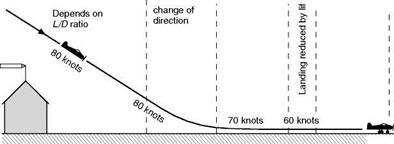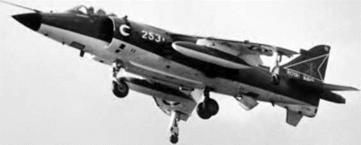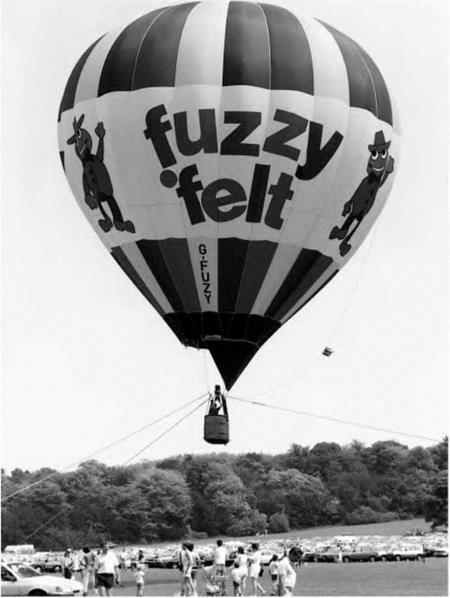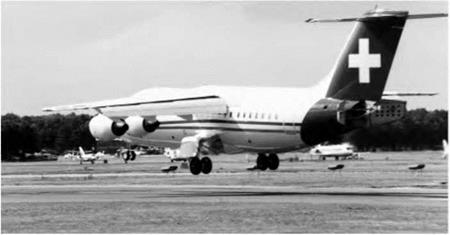The complete approach and landing
During the few years preceding the Second World War, a new technique in flying was developed. In this book we are not concerned with the art of flying as such, but we are very much concerned with the alteration of technique because it was brought about by progress in the science of flight accompanied by the corresponding changes in aeroplane design. To the outward eye the main change was that the monoplane, rather suddenly, took precedence over the biplane. Less obvious, perhaps but more important, was the increase in wing loadings – which incidentally was itself the reason behind the ascendancy of the monoplane. With increase in wing loading came higher landing speed,
|
|
Fig 6G V/STOL
The Harrier is capable of vertical take-off, very short take-off, and conventional take-off using its vectored-thrust Pegasus turbofan engine; it can also hover and fly sideways or backwards. Control at low speed is by reaction jet nozzles situated at the wing-tips and either end of the fuselage.
(Photo courtesy of Nigel Cogger)
|
|
Fig 6H VTOL – another way
After a century of neglect, the hot-air balloon has made a major comeback. This one is tethered and is being used for pilot training. The wicker basket provides good impact absorption on landing.
higher landing speed meant that flaps – once a luxury – became a necessity, and flaps, in their turn, were largely responsible for the new technique, especially in so far as it affects the approach and landing.
A pilot, when approaching a landing ground, may find that he is either undershooting or overshooting. If he is undershooting there is little that he can do (assuming, of course, that he is already gliding at the best angle) except use his engine power to flatten his glide. In the old days such a method was considered bad flying; if the engine was functioning satisfactorily, it showed lack of judgment; if the engine was out of action – that is to say in the case of a forced landing – it could not be done. Nowadays the engine-assisted approach, as it is called, is a standard method of approaching to land. It might almost be said that on the most modern machines the glide approach is only used as practice for a forced landing.
In the anxiety to avoid undershooting there is a natural tendency to overshoot, especially since it would seem to be easy to lose any unnecessary height. In practice it is not quite so easy. In older types of aircraft the following methods were available as means of losing height in the event of overshooting –
(a) Sideslipping.
(b) Prolonging the glide by S-turns.
(c) Putting the nose down and gliding fast.
(d) Holding the nose up and gliding slowly.
The objections to the last two have already been explained; the first two methods, on the other hand, were successfully employed for very many years.
Then came the modern type of aircraft – its superior streamlining gave it a very flat gliding angle, so flat that even a slight degree of overshooting caused it to float much too far before landing. But that was not all – it did not like sideslipping (reasons for this will be given later), and with its very flat angle of glide the S-turn did not result in sufficient loss of height.
Necessity may be the mother of invention, but in this little bit of aviation history the invention existed before the necessity arose; flaps had been in use for many years, but they had not really been fully applied to their modern purposes. These purposes can best be described by considering the process of approaching and landing a light private aircraft by the old-fashioned glide approach technique. This typically consists of five separate phases (Fig. 6.9) – the glide, the flattening-out, the float or hold-off, the landing, and the pull-up. In each and all of these flaps have their part to play. Tet us consider them in turn.
First, then, let it be understood that the last 150 m or so of the glide should be straight, without any slipping or turning to one side or the other. This can only be done if the pilot has means of controlling the gliding angle relative to the earth without unduly raising or lowering the air speed. Flaps can give him
the means to do this, at any rate over a limited range of gliding angles. As the flaps are lowered both lift and drag are increased. The increase in lift tends to flatten the gliding angle and to make it possible to glide at a slower air speed without approaching dangerously near to the stall. The increase in drag tends to steepen the gliding angle, and gliding attitude, of the aeroplane for the same air speed. The net effect depends on whether lift or drag has the greater proportional increase, i. e. on whether the T/D ratio is raised or lowered, and that in turn depends on how much the flaps are lowered and on the type of flap.
So much then for the actual glide – we can sum it up by saying that flaps give us at least some control over the gliding angle (Fig. 61, overleaf).
Next comes the process of flattening out; this involves a change of direction, and so an acceleration, and force, towards the centre of the curved path. This force must be provided by the wings which must therefore have more speed and more angle, so in effect the stalling speed is higher. Now the steeper the original glide, the greater the change in flight path involved, and so the more speed must there be in hand for flattening out. All this is very annoying – it means that the more steeply we glide, the faster must we glide; just what we were trying to avoid. The solution is to use engine power, as we shall consider later.
After flattening out, we must lose any excess speed – this may be called the float or hold-off. In this the drag of flaps or air brakes play their part, as do the wings themselves as they are brought to the angle for actual landing.
![]()
![]()

![]()
![]()

 |
 |
After the float comes the landing (Fig. 6J, overleaf). This, in a sense, is momentary only but the landing speed is of the utmost importance because it settles both the gliding speed and the distance to pull up after landing. The problem of landing speed has already been fully discussed, but it must be emphasised –
Fig 6.9 The approach and landing
Air speeds shown are approximate only, but indicate at what parts of the approach and landing there is a loss of air speed.
|
|
Fig 61 Ready for landing
The huge Antonov AN-124 with Fowler flaps and leading edge slats extended, and undercarriage lowered, showing the ten pairs of main wheels.
because it is so often misunderstood – that drag, whether caused by flaps or anything else, cannot reduce landing speed; that is entirely a question of lift.
After the landing, the pull-up. This at least is easy to understand; what we need for a quick pull-up is drag – wheel brakes and air brakes – the more the better, provided the aircraft can stand it and does not tip on its nose. In addition to actual air brakes, some types of flap, when fully lowered, give good braking effect, and so do the wings at their angle of 16° or so with a tail-wheel type of undercarriage. The lack of air drag during the landing run is one of the few disadvantages of the nose-wheel type – an effective substitute, sometimes used, is a tail parachute (Fig. 6K, overleaf), and, perhaps most effective of all, reversible pitch propellers or reversed thrusts of jets. The air-braking effect is greatest at the beginning of the landing run, the wheel-braking later when it can more safely be used. The problem of brakes is a straightforward one of mechanics, but apart from the question of coefficient of friction between wheels and ground, and the serious danger of ‘aquaplaning’ when there is water on the runway, there are some aspects of brakes which are peculiar to aircraft. For instance, the centre of gravity is high above the wheels, though not so much with jets as with propellers; it is also, with a tail-wheel type of undercarriage, only a short distance behind the wheels, and so, if the brakes are applied violently there is an immediate tendency to go over on to the nose. Another difficulty is that if a tail-wheel aeroplane starts to swing, the centre of gravity, being behind the wheels, will cause the swing to increase. This may be checked by the differential action of the brakes, but it is interesting to note that
the tricycle or nose-wheel undercarriage (Figs 6J, 6K and others) can remove the cause of this and other troubles. When this type of undercarriage is used, as it is almost universally on modern aircraft, the centre of gravity is in front of the main wheels and there is no tendency to swing, and at the same time the aircraft is prevented from going on to its nose by the front wheel. The effect on braking, and consequent shorter pull-up has to be seen – or, better still, tried – to be believed. And there are other advantages too.
So much for the glide approach and landing; for forced landings it is the only way. For approaching over high obstacles at the edge of an airfield it may also come in useful. In all other circumstances, with modern types of aircraft, the engine-assisted approach is better, so let us sum up the reasons as to why it is preferred –
1. By slight adjustments of the throttle the path of glide can be flattened or steepened at will.
2. The gliding path is flatter, so there is less change of path in flattening out, less acceleration, less extra lift required, less increase in stalling speed, and thus less excess speed is needed, and the glide can safely be made more slowly.
3. In propeller-driven aircraft the extra speed of the slipstream over elevators and rudder makes these controls more effective – their effectiveness enables us to counteract wind gradient and turbulence effects near the ground.
4. Since there is less excess speed to be lost, the float is reduced.
|
|
Fig 6) Landing
A BAe 146 about to touch down, Fowler flaps extended and rear air-brake doors open.
|
|
|
|
Fig 6K Pulling up after landing
Eurofighter Typhoon using an arrester parachute to reduce the landing run.
5. An engine, already running, will respond more readily to the throttle if it is found necessary to make another circuit before landing.
6. For all the reasons already given less judgment is required – the whole process is easier.
Well, all that sounds pretty convincing, and not only is it perfectly sound reasoning but it is amply confirmed by experience.
As was mentioned in Chapter 3 many modern types of aircraft are literally ‘flown onto the ground’ at speeds well above the stalling speed; this is where real lift dumpers come into their own – these are larger than normal air brakes or spoilers, and cannot be operated unless the undercarriage is locked down, and the aircraft is bearing on the wheels and the engines throttled back – they ‘kill’ the lift, keep the aircraft on the ground and make the wheel brakes more effective. They are essentially for use after landing, and are a common feature on gliders.

















